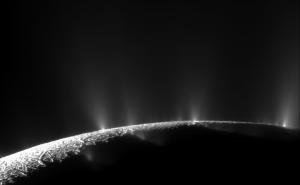The most recent spacecraft telemetry was acquired on Dec. 21 from the Deep Space Network tracking complex at Madrid, Spain. The Cassini spacecraft is in an excellent state of health and all subsystems are operating normally.
The most recent spacecraft telemetry was acquired on Dec. 21 from the Deep Space Network tracking complex at Madrid, Spain. The Cassini spacecraft is in an excellent state of health and all subsystems are operating normally. Information on the present position and speed of the Cassini spacecraft may be found on the “Present Position” page at: http://saturn.jpl.nasa.gov/mission/presentposition/.
Wednesday, Dec. 15 (DOY 349)
Real time commands to normalize the flight software loads for Attitude and Articulation Control Subsystem (AACS) A8.8.0, Cosmic Dust Analyzer (CDA) V10.0.4, and Composite Infrared Spectrometer (CIRS) began last week and were successfully completed today. At all times there are four copies of FSW on the Solid State Recorder (SSR). Normalization makes all copies equivalent, and identical software versions are available on all partitions.
A real time command to patch the Command and Data Subsystem (CDS) FSW SSR scrub process table was sent today. This was sent in response to Incident Surprise Anomaly (ISA) #47210 “Increased SSR SBE/DBE Counts Following CDS Swap”. It set SSR-A sub-module 39 to OFF in the process table so that the single and double bit errors will no longer be counted. SSR-A sub-module 39 was turned off in Oct. 2007 due to memory cell failures, but the SBE/DBE counting had been re-enabled as a consequence of the Nov. 2 safing event.
Thursday, Dec. 16 (DOY 350)
Orbit Trim Maneuver (OTM) #271, the final E-13 approach maneuver planned for Dec. 17, was cancelled today. Navigation analysis found that cancelling the maneuver does not increase downstream delta-V costs and that the Enceladus flyby altitude will be only about 600 m higher than originally planned.
Friday, Dec. 17 (DOY 351)
This week in science, the Cosmic Dust Analyzer completed 13.5 hour and 21 hour interstellar dust observations. The Cassini Plasma Spectrometer (CAPS) made a 7 hour measurement of the low latitude region of Saturn’s magnetosphere, followed by an 11 hour observation conducted by the Ultraviolet Imaging Spectrograph (UVIS) and the Visual and Infrared Mapping Spectrometer (VIMS) of Saturn’s auroral emissions. A Titan cloud monitoring campaign observation was performed by Imaging Science (ISS), the Composite Infrared Spectrometer (CIRS), and VIMS. Next, approaching periapsis, Cassini performed an ~100,000 km flyby of Dione, during which VIMS made a six hour observation of the surface composition of this interesting moon.
CIRS took four hours’ worth of temperature maps of the night side of Dione, with additional compositional measurements by UVIS and VIMS. ISS took observations of the lit crescent of Dione, capturing detailed topographic images. The Dione observations were followed by the Enceladus observations during the E-13 flyby.
Commands were uplinked today for the CDA E13 FSW reset/reload sequence, which will begin execution shortly after the E-13 flyby.
Sunday, Dec. 19 (DOY 353)
This weekend, the AACS secondary safe table value was set to 170 degrees and the main engine cover was closed in preparation for the E-13 flyby.
Monday, Dec. 20 (DOY 354)
The Cassini mission website elves have three Holiday Saturns now available on the Cassini mission website. To see what the web elves have done to Saturn, hit your refresh button three times at http://saturn.jpl.nasa.gov/.
Tuesday, Dec. 21 (DOY 355)
Today Cassini flew by Enceladus at an altitude of 47.8 kilometers and a speed of 6.2 km/sec. Closest approach occurred at 2010-355T01:08 at a latitude of 61°N. This observation sequence started with optical remote sensing (ORS) observations of the plume at the south pole. CIRS performed a night-side temperature map. Next was a unique opportunity for a stellar occultation by Saturn, wherein VIMS observed the star alpha Orionis as Saturn passed in front of it to measure the absorption of the stellar light by the Saturnian atmosphere. ISS then continued the Enceladus observations with more high-phase plume monitoring measurements. The ion and neutral mass spectrometer (INMS) took over as Cassini passed over the moon’s northern hemisphere at closest approach. The focus of this flyby was fields-and-particles measurements of the environment in the northern hemisphere, away from the plume. On the outbound leg of the trajectory, the ORS instruments observed the dayside of Enceladus for geologic and compositional mapping.
The AACS secondary safe table value was restored to 0 degrees today, and the main engine cover was opened. This was the 63rd in-flight cycle.
Files were uplinked today over Canberra’s DSS-43 track for the INMS SSR Instrument Expanded Block (IEB) load and the CDS SSR repair. The files successfully executed on board and all of the SSR verify/Memory Readout (MRO) results came back normally.
A news release called “Cassini Marks Holidays with Dramatic Views of Rhea” is available on the Cassini web site. Images of Saturn’s second largest moon Rhea obtained by NASA’s Cassini spacecraft show dramatic views of fractures cutting through craters on the moon’s surface, revealing a history of tectonic rumbling. The images are among the highest-resolution views ever obtained of Rhea. For more information on this subject and images, link to: http://saturn.jpl.nasa.gov/news/newsreleases/newsrelease20101221/.
A feature story called “Cassini Finishes Sleigh Ride by Icy Moons” is available on the Cassini web site. It describes how recently returned images of Enceladus show several separate jets, or sets of jets, emanating from the fissures known as “tiger stripes.” Scientists will use the images to pinpoint the jet source locations on the surface and learn more about their shape and variability. For more information on this subject link to: http://saturn.jpl.nasa.gov/news/cassinifeatures/feature20101221/.
































